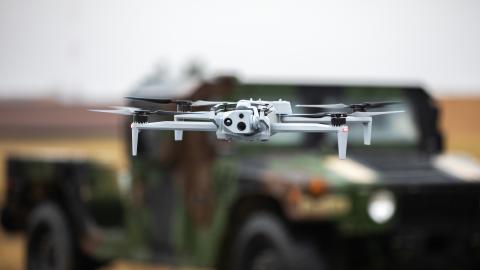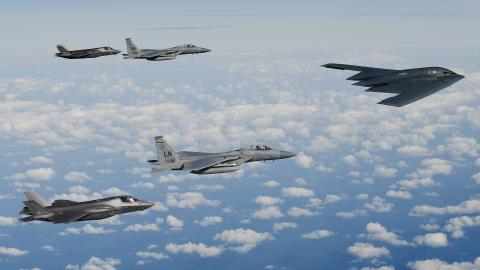Table of Contents
I. Introduction
By Rebeccah L. Heinrichs
II. Deterring and Responding to Escalation: What the US Needs and Why
By Matthew R. Costlow
III. Arms Racing and Reality: Why the Action-Reaction Phenomenon Is a Myth
By Kyle Balzer
IV. What the Russia-Ukraine War Teaches about Deterrence Failure and Escalation
By Ryan Tully
Introduction
By Rebeccah L. Heinrichs
Nuclear Coercion in the Current Threat Environment
The United States is in a new era of significant danger. The US-led international order, which America and its democratic allies and partners have maintained since World War II, is at risk. A new axis of authoritarian powers comprising China, Russia, North Korea, and Iran is working hard to undermine and ultimately break this US-led order in what amounts to a second cold war.
The order is defined, more concretely, as a network of US-led alliances that together enforce certain norms and agreements. Those norms and agreements have encouraged the development and strengthening of an international system that favors democratic governance, the rule of law, and the predictable and responsible use of the global commons, including international waters and the undersea, cyber, and space domains. The US-led system has facilitated an explosion of economic prosperity and maintained relative stability and security compared to previous centuries. The American people are the greatest beneficiaries, but US allies and partners have also profited. To be an ally of the United States is to participate in the formation and enforcement of these norms and agreements, a privilege undergirded by the threat of force from American and allied militaries.
The axis of adversaries has discovered that the most direct way to break this US-led order is to undermine the credibility of America’s military alliances. The US military maintains international order by following through on Washington’s security commitments. Knowing this, adversaries continually change their force compositions and military doctrines to gain an advantage over US forces. To replace the current order with one that is more favorable to totalitarian systems of government, the axis needs to achieve one strategic aim: to sufficiently degrade the perception that America can credibly project power to defend its allies and maintain nuclear deterrence and assurance.
Thus, China, Russia, and North Korea do not have to attack the United States or its allies directly to achieve the axis’s aim of toppling the US-led order. Instead, they can use nuclear coercion to dissuade the United States from supporting its allies by threatening uncontrolled escalation.
Washington should adapt its strategic posture and composition to meet this threat and convince adversaries they cannot outmaneuver or out-escalate the United States. If America fails to adapt its forces, its adversaries will be more able to successfully coerce the US and harm American credibility. Adversaries do not have to employ nuclear weapons to use them effectively. Russia, for example, is already using nuclear coercion to invoke fear among US policymakers and deter the United States from taking certain actions to support Ukraine.
How the US Should Respond
This essay compilation seeks to clarify how adversaries may use nuclear weapons to coerce the United States, and it demonstrates how US force buildups and support for allies do not necessarily precipitate escalatory spirals. Observing which actions and inactions correlate with adversary nuclear threats can help policymakers determine how America can achieve its desired political and strategic outcomes. Policymakers should also analyze what the United States can do to strengthen its ability to overcome coercion and carry out its national objectives with an informed assessment of escalation dynamics.
The authors wrote independently, but there are several common themes among the essays.
1. Nuclear coercion is a defining characteristic of the new cold war. Matthew Costlow’s essay discusses how America’s failure to maintain and adapt the nuclear deterrent has emboldened adversaries to pursue nuclear coercion. The United States has sought to lessen the salience of nuclear weapons in its national defense strategy since the first Cold War. But in the meantime, America’s adversaries have increased the role that nuclear weapons play in their defense strategies as they seek to replace the US-led international order.
The prime example is Russia, which has deterred the United States and its North Atlantic Treaty Organization allies from giving Ukraine sufficient materiel and capabilities to repel Moscow’s unprovoked aggression. The Biden administration has publicly taken a cautious approach in order to avoid “nuclear Armageddon.” Iran, on the other hand, is not a nuclear power. But its ever-shortening timeline to achieving a bomb also seems to cause the United States to fear a wider regional war between Iran-backed terrorist militias and Israel, America’s democratic ally in the region. US policymakers have therefore demanded de-escalation.
2. American restraint has emboldened adversaries to escalate further. Kyle Balzer’s essay discusses this in the context of the Cold War arms race. Unilateral American restraint in the 1960s and early 1970s did not convince the Soviet Union to slow its nuclear buildup. Instead, it allowed the Soviets to build a material advantage over the US and its allies. Conversely, a concerted buildup of the US nuclear deterrent in the late 1970s and 1980s forced the USSR to agree to significant arms control measures.
Ryan Tully writes about how the chaotic American withdrawal from Afghanistan invited the Russians to invade Ukraine, and how America’s escalation-wary posture has given Russia a material advantage and prolonged the conflict. Historic parallels demonstrate that a more muscular American policy toward the conflict in Ukraine would actually be more likely to de-escalate the conflict.
Recommendations
To safeguard American interests and the alliances that underpin the US-led international order, the United States would be wise to do the following:
- Continue to work with allies to increase the credibility of nuclear assurance and guard against nuclear proliferation. Nonnuclear NATO allies could expand their roles by providing additional conventional capabilities or certifying appropriate conventional platforms for a potential nuclear mission. In the Indo-Pacific, allies might be open to hosting US nuclear forces or training for a collaborative nuclear mission akin to NATO’s.
- Field more theater-range nuclear options to bolster the credibility of regional deterrence. The US strategic deterrent should convince adversaries they cannot cross the nuclear threshold in a regional theater, regardless of the yield, to successfully achieve their military objective. To achieve this, the US needs to demonstrate the capability to decisively win a nonstrategic nuclear exchange.
- Complement offensive weapons with active defenses to undermine adversaries’ confidence that they can hold at risk critical US installations.
It is a mistake to dismiss nuclear threats as a bluff. Adversaries could indeed employ nuclear weapons to degrade US and allied forces or harm American citizens. US adversaries did not buy into the American view of strategic stability, nor did they accept the US-led order. They have modernized and adapted their militaries to target, weaken, and undermine US alliances, and are far more open to employing nuclear weapons both on the battlefield and using them as tools of coercion.
The United States should carefully reassess its assumptions surrounding action-reaction cycles and escalation dynamics. By failing to fully back its allies, America does not avoid escalation; rather, it allows adversaries to control the pace of escalation and cement their advantage.
Washington would be wise to bolster the credibility of US nuclear assurance and deterrence so that it can confidently demonstrate to its allies and its adversaries that US forces can fulfill America’s military commitments. By strengthening the credibility of US alliances, the United States will better deter adversaries and maintain the US-led international order and the security, peace, and prosperity it has brought.
Deterring and Responding to Escalation: What the US Needs and Why
By Matthew R. Costlow
Introduction
The United States faces a strengthening political and military entente among three nuclear-armed adversaries—China, Russia, and North Korea—plus Iran, which is on the brink of having such weapons. These states are increasingly comfortable using the threat of nuclear escalation to advance their coercive national agendas—unilaterally when needed and cooperatively when beneficial. Meanwhile, US policymakers are debating the appropriate size and role of America’s nuclear and homeland missile defense programs. The results of the current debate will affect the US strategic posture well into the 2080s. While America’s adversaries grow increasingly confident in threatening escalation, the US nuclear and missile defense modernization programs remain in their early stages. Therefore, US officials need to seize this critical opportunity to identify and develop the fundamental capabilities required for the future.
This paper begins with a brief explanation of why the rise of coercive nuclear strategies among America’s adversaries should concern US policymakers. Then it examines three lines of effort that will be central to America’s ability to deter escalation—or manage its effects—in the coming decades.
First, the United States needs to acquire and maintain sufficient strategic nuclear forces to deter escalation; an adversary is less likely to attempt escalation if it concludes there is no plausible theory of military victory at the highest levels of violence. Second, the United States should diversify and grow its nonstrategic nuclear forces—namely those forces not covered under the New START Treaty—because short- to intermediate-range weapons play a unique role in combating nuclear coercion. Third, the United States needs to invest significant additional resources, in both the short and long term, in homeland missile defenses to improve deterrence by denial and limit damage should deterrence fail. These three elements support and improve each other’s effectiveness—a crucial factor of any program dedicated to deterring the most consequential adversary action imaginable: nuclear escalation.
Escalation Threats Are Increasingly Important in Coercive Nuclear Strategies
Russia, China, and North Korea all employ nuclear-backed coercive threats against the United States and its allies. These threats are coercive in that they aim to overturn the status quo. Though each nation has its own messaging style and strategic ends, the basic formula remains the same. The hallmarks of Vladimir Putin and his cadre’s nuclear threats are frequency and lack of subtlety. Russian military writings frequently identify the goals of limited military strikes as (1) making the adversary fear the consequences of additional escalation and (2) causing the adversary to believe additional escalation is even more likely. China’s leaders, meanwhile, prefer to let their actions speak—and Beijing’s “breathtaking” nuclear expansion speaks volumes. China has gone from a minimum deterrent to an arsenal projected to be on par with the United States in just under 15 years. North Korea’s leaders also use bombastic rhetoric in their nuclear threats. But again, the exaggerated frequency of these threats does not diminish the underlying reality that they are backed by a growing nuclear arsenal.
Thus, effectively countering nuclear coercion has become a key issue for US officials. China, Russia, and North Korea are increasingly comfortable using nuclear escalation threats as a primary means of affecting US political perceptions—both in peacetime and crisis. Stated bluntly, these adversaries speak the language of coercion more fluently than the United States. This is not to say that the United States cannot issue effective deterrence threats. But, as Under Secretary of Defense for Policy Fred Iklé said during the Cold War, America’s adversaries are “schooled in the uses of terror for political ends,” both for their domestic and foreign policies, in ways that US officials simply are not. During a crisis or conflict, these adversaries may find implicit and explicit nuclear threats to be an effective deterrent against what they perceive as a conventionally superior United States.
US officials need not match their adversaries’ escalatory rhetoric point-for-point; instead, Washington should focus on building military capabilities that demonstrate political resolve and add credibility to deterrence threats against adversary escalation.
Keeping General Nuclear War Unthinkable
US strategic nuclear forces act as the ultimate backstop against adversary escalation threats. As the scholar Colin S. Gray noted in the context of the Cold War:
The American public needs to understand, if it does not already, that it is protected directly by, and only by, its strategic nuclear forces. The accomplishments of every other element of US military power can be “trumped,” negated, or really rendered close to irrelevant if Soviet leaders believe that they have a military success option at hand at the level of central conflict. The physical survival of Americans at home in time of general war will be very directly dependent upon Soviet calculation of the outcome of a central nuclear “exchange.”
This remains true of America’s current adversaries. In other words, US strategic nuclear forces need to be sized and postured such that, even in the worst-case scenario, the United States can credibly threaten to impose unacceptable costs on any adversary or set of adversaries.
China’s strategic nuclear breakout, in addition to Russia’s already significant arsenal, will likely exceed the central deterrence requirements the US set around 2010 during a more benign time in the international environment. In 2023, two major bipartisan studies agreed that the currently planned US strategic modernization program is “necessary but not sufficient” for the future. Because China will soon become a second nuclear peer to the United States, US officials should plan to deter two adversaries simultaneously or in quick succession. This dilemma greatly affects the design of the US strategic force posture, as one major study explains:
If the United States ever has to fight a war involving nuclear use, it should never be in a position where it lacks the ability to deter existential threats. That is, the United States must always be capable of inflicting intolerable costs on a peer nuclear adversary—even after a preemptive strike on its forces and a follow-on large-scale exchange. The temptation for others to exploit that vulnerability could be disastrous.
To summarize, the United States needs to adapt its strategic nuclear force requirements to make general nuclear war unthinkable to China’s and Russia’s leaders under all scenarios—especially the worst-case scenario—to deter escalation at lower levels of violence.
Limited Nuclear Deterrence Threat Options
Defense planners thus need to determine how best to deter China or Russia from escalating a conventional war into a limited nuclear war, or from expanding a limited nuclear war to something worse. Part of the solution is providing US leaders additional limited nuclear deterrence options. The value of a diverse range of limited nuclear employment options is that it can meet deterrence requirements when a US president wishes to demonstrate both “resolve and restraint.” As William Van Cleave and Roger Barnett write:
The ability to conduct selective and limited nuclear strikes for express and restricted purposes while holding major retaliatory forces in reserve . . . provides an important hedge against the inability to predict deterrence thresholds for a range of situations, promotes the possibility of escalation control, and increases opportunities for war termination without major urban damage.
Here again, China’s rapid expansion of its nuclear arsenal stresses America’s ability to deter limited nuclear conflict. US forces now have to credibly cover a range of scenarios in two vastly different and physically distant theaters in Europe and Asia.
To address these challenges, the US reportedly has only a few hundred B61 nuclear gravity bombs in Europe, and the nascent nuclear-armed sea-launched cruise missile (SLCM-N) program is not planned to arrive until 2034. Other selective nuclear employment options, like bombers carrying cruise missiles, might be insufficient for an opportunistic or coordinated aggression scenario when the demand for US aerial refueling capabilities will reach its maximum in both Europe and Asia. In this context, and given US allies’ rising demands for improved extended deterrence, Washington should prioritize acquiring SLCM-N sooner and developing regional ground-based nuclear-armed systems that it can deploy in theater if needed.
Having nuclear capabilities with diverse yields, ranges, flight patterns, and basing modes would support US deterrence by demonstrating America’s political will and giving the president a tailored set of options to convey any intended deterrent threat.
Homeland Missile Defense as a Deterrent and Deterrence Enabler
The final crucial element in a US strategy to deter nuclear escalation is a set of integrated air and missile defense (IAMD) capabilities to defend the homeland. While regional IAMD is important, homeland IAMD is more fundamental to the US national defense strategy. Homeland-to-homeland missile strikes between nuclear peers represent a potentially critical escalation point in a conflict. Thus, to strengthen deterrence, the United States should raise the threshold of difficulty—the proverbial price of entry—for China or Russia to attack the US homeland.
US defense and policy officials need to understand that it is impossible to know beforehand precisely what is necessary for deterrence in a given scenario. Therefore, prudence dictates a combination of deterrence threats of denial and deterrence threats of cost imposition to decrease the chances that an adversary will believe it can launch a successful strike at an acceptable cost. Solely relying on threats of cost imposition to deter attacks is a dangerous gamble. As stated in a Center for Global Security Research bipartisan working group report:
US threats to respond by nuclear means to nuclear attack may be dismissed by adversary leaders as not credible for various reasons. Those leaders may believe that [mutual assured destruction] at the strategic level of war gives them protection against escalation, freeing them to engage in nuclear risk-taking in regional war. Or they may judge the United States, and democracies generally, as politically weak, easily divided and thus paralyzed, and fearful of escalation and thus conclude that their nuclear threats can be ignored.
In these scenarios, supplementing US nuclear deterrence threats of cost imposition with deterrence threats of denial may be critical to preventing a deterrence failure that leads to escalation.
Homeland IAMD is unique in that it both deters attacks in its own right and strengthens other deterrence threats. Defending America’s seaports with air and missile defense, for example, can deter coercive attacks meant to cripple vital American military infrastructure and dissuade US support for allies overseas. Additionally, homeland IAMD would limit damage to these seaports and enable them to continue to project power—simultaneously a deterrent threat and an enabling element of deterrence.
The United States should abandon its current approach of deterring Chinese and Russian missile strikes against the homeland solely through the threat of attacks in response. This strategy is akin to a boxer choosing to fight with one hand tied behind his back, rendering himself unable to block a punch. Instead, US officials need to recognize the severity of China’s and Russia’s escalatory threats and utilize all possible means, including homeland IAMD, to deter them.
Conclusion
Even as the Chinese, Russian, and North Korean nuclear threats grow, the United States is well positioned to respond effectively—so long as policymakers demonstrate leadership and the necessary political will. These adversaries are well-practiced in terror-inducing threats. Indeed, their political survival is largely built on such threats. Therefore, the United States should maintain the necessary nuclear forces at the strategic and nonstrategic levels to produce a clear and convincing deterrence threat that any attack will invite unacceptable consequences. As Thomas Schelling recognized, “It is far from obvious that all nations want to stop playing chicken, and the only way to make them want to stop is to see that it is played properly against them.” Yet deterrence threats of cost imposition should be accompanied and strengthened by parallel threats of denial. Adversaries should anticipate the worst of both worlds when contemplating an attack against the US homeland: an ineffective strike and an unacceptable response.
The dynamics of escalation may appear arcane in peacetime. But, in a nuclear conflict, deterring escalation will quickly become the capability on which the continuity of civilization depends. America’s policies should reflect this fact.
Arms Racing and Reality: Why the Action-Reaction Phenomenon Is a Myth
By Kyle Balzer
With Russia engaged in a criminal war on the European continent, the specter of nuclear escalation now looms over Russia–United States relations for the first time since the Soviet collapse. But the Russia-Ukraine War will eventually end, and US officials will need to adjust to a new era of peacetime nuclear competition with the Kremlin. Moscow will undoubtedly remain an adversary for the foreseeable future, and the axis of Eurasian autocracies that now supports the Russian war machine only complicates the deterrence challenge in Europe.
Unfortunately, a pervasive myth clouds the debate over how to size and shape the US nuclear posture for a long struggle with Russia. This debate frequently veers off course due to the fear of a tightly coupled action-reaction competition, or the idea that expanding the US nuclear arsenal will provoke Russia and ignite a destabilizing arms race. The historical record suggests that this model of peacetime arms interactions obscures more than it predicts. The Cold War showed that US policymakers should not accept the action-reaction myth, and that restraining American nuclear capabilities could weaken the North Atlantic Treaty Organization and encourage further Russian aggression.
What follows is a brief examination of the action-reaction myth in three parts. The first reviews its origins and enduring influence. The second examines how the action-reaction model damaged the credibility of American extended deterrence during the middle years of the Cold War, and how a bipartisan group of defense planners revived it for the 1980s. The third and final section draws relevant lessons from the Soviet-American rivalry, emphasizing that arms control and strategic stability are—counterintuitively—a function of nuclear competition.
The Origins and Sustainment of the Action-Reaction Myth
The idea of an action-reaction arms race traces to the great-power nuclear rivalry between the United States and the Soviet Union. In the late 1960s, the Soviets initiated a massive nuclear expansion that many US officials perceived as a defensive reaction to America’s early nuclear dominance. Many assumed that the Soviets were merely imitating the US capacity to absorb a large-scale attack and then retaliate by assuring the destruction of the adversary society. US officials thus concluded that the Soviets shared the American conception of nuclear deterrence and were merely safeguarding their assured destruction force against a superior opponent. The idea of mutual assured destruction (and the idea that the Soviets would invariably reciprocate US behavior) was born.
As such, Secretary of Defense Robert McNamara, in a 1967 address, made the case that American restraint could arrest the Soviet nuclear expansion. “Whatever their intentions or our intentions,” he warned the audience, “actions . . . on either side relating to the buildup of nuclear forces necessarily trigger reactions on the other side.” The defense secretary thus cautioned that a further expansion of US strategic forces would constitute “a profitless waste of resources” and would likely “trigger a senseless spiral upwards of nuclear arms.” Therefore, it would be better to restrain the US force posture and deprive the Soviets of the engine of their buildup. The alternative, McNamara submitted, was an unconstrained arms race that risked escalation to full-blown nuclear warfare.
McNamara’s diagnosis of a tightly coupled arms race and his prescription to end it received strong support from the arms control community. George Rathjens, a Massachusetts Institute of Technology professor and former defense official, concluded in 1969 that “the action-reaction phenomenon . . . has clearly been a major stimulant of the strategic arms race.” He urged US officials to “recognize that breaking the action-reaction cycle should be given first priority in any negotiations, and also in unilateral decisions.” Paul C. Warnke, a leading advocate of restraint and one of McNamara’s civilian deputies, reduced the ongoing Soviet buildup to a “monkey see, monkey do” response to US force modernization. In an influential 1975 Foreign Policy article, he characterized the superpowers as apes “jogging in tandem on a treadmill to nowhere.” Having provoked Moscow into building up, Washington should take full responsibility and be first off the metaphorical exercise belt. “The Soviets,” Warnke contended, “are far more apt to emulate than to capitulate.”
In reality, however, the Soviets were far more eager to compete than to emulate. Despite the American arms controllers’ abiding faith that goodwill begets goodwill, unilateral US restraint could not break the Soviet buildup because the Kremlin categorically rejected the American style of nuclear deterrence.
Soviet force planners scoffed at McNamara’s notion of mutual assured destruction and could not fathom the idea of an irreversible nuclear stalemate. “If there were a [technological] breakthrough,” a Soviet general staff officer insisted, “it would take a certain amount of time to develop the means to counteract it, and that every such time lag gave a temporary technological superiority, and that technological superiority allowed political pressure to be brought to bear [in peacetime].” Soviet planners thus considered stability not a shared international commodity but a one-way street—a function of Soviet nuclear superiority.
Even without this competitive philosophy, however, the threefold increase in Soviet nuclear arms during the 1970s would have proceeded irrespective of US force development. Due to the insatiable appetite of the Soviet defense industry, the Kremlin knowingly deployed more nuclear weapons and delivery systems than was militarily necessary. According to another general staff officer, the defense industrialists “kept producing what they wanted to produce, and the desires of the military customers continued to be ignored.” This dynamic, a senior Soviet missile designer admitted, “led to a kind of internal arms race inside the defense industry, which did not always adequately reflect the country’s defense requirements.” For the Soviets, then, the health of their militarized command economy—not American force development—constituted the fundamental criterion of nuclear planning.
Indeed, even as US strategic forces plateaued in the mid-1960s, the Soviet land-based missile buildup blew past its rival at a clip that shocked American intelligence estimators. By the mid-1970s, the Kremlin enjoyed a two-to-one advantage in deliverable missile payload, or total “throw-weight.” US officials fretted that this throw-weight gap would grow to five-to-one, and they were alarmed that continued American restraint would, in time, cede a devastating counterforce advantage to the Soviets. Former US officials even warned of a potential window of vulnerability in the mid-1980s when the Soviets might, after wedding their heavy missiles to improved guidance systems, be able to conduct a crippling first strike on US missile silos.
Notwithstanding the adverse consequences of unilateral restraint during the Cold War, the fiction of an action-reaction arms race continues to captivate US officials and analysts alike. For instance, National Security Advisor Jake Sullivan emphasized the Biden administration’s determination to prevent another wasteful and dangerous arms race in a June 2023 address at the Arms Control Association (ACA). The message was clear: the United States would not, as it did during the Cold War, destabilize the nuclear balance by provocatively expanding its arsenal. “We’ve been there. We’ve learned that lesson,” Sullivan reassured the ACA audience.
Furthermore, after the bipartisan Congressional Commission on the Strategic Posture of the United States recommended steps to grow the US nuclear arsenal in October 2023, many within the think tank community warned that such measures would set off an explosive action-reaction duel. “Right now,” one analyst cautioned, “too many American nuclear experts are beginning to warm up to the idea of an arms race.” These critics contend that during the Cold War, US officials persuaded the Soviets that American deterrence logic was correct and that restraint ultimately fostered stability. They therefore urge US officials to dust off this idealized playbook to manage Russia today. “The United States,” as one analyst recently warned, “is already in an action-reaction cycle with China, just as it has been with Russia for decades. Ignoring this reality will make it much harder to find stable outcomes.”
Given the pervasiveness of this action-reaction narrative, it is worth reexamining how the United States actually managed to “find” a stable outcome during the Cold War. And, given the enduring attraction of unilateral restraint today, it is worth exploring the decisions that actually roiled the nuclear balance in the 1970s—and how a bipartisan group of American defense planners redressed the situation and revived the strategic posture for the 1980s.
Decline and Revival
Captivated by the action-reaction diagnosis and the allure of unilateral restraint, Defense Secretary McNamara made two shortsighted decisions in the mid-1960s that had dire long-term consequences. First, he effectively killed a next-generation heavy missile program, the Advanced Intercontinental Ballistic Missile (AICBM). The US would have deployed this delivery system in the early 1970s as its first reliable counterforce missile. Since the existing lightweight Minuteman intercontinental ballistic missile (ICBM) lacked the accuracy and striking power to disable hardened silo launchers, the United States was bereft of a missile capable of limiting collateral damage to both the Soviet and American homelands. Constraining US targeting capabilities, however, was precisely McNamara’s intention. As Warnke later rationalized the demise of AICBM: “The fine tuning of our nuclear weapons and delivery systems could create fears of counterforce attack on the other side and hence be destabilizing.”
McNamara’s resolution to withhold the development of the Advanced Manned Strategic Aircraft (AMSA) only compounded the harm of the AICBM decision. For most of the 1970s, the B‑52 bomber remained the most discriminate strike option in the US arsenal—even after the third-generation Minuteman came online in 1970. Yet compared to AMSA’s supersonic speed and terrain-hugging avionics, the slower and higher-flying B‑52 was more vulnerable to dense Soviet air defenses. McNamara’s restraint thus robbed the US of a robust capability to spare Soviet cities and conduct selective strikes on military assets.
As such, after the Soviets fielded a secure counter-deterrent in the late 1960s and unexpectedly achieved quantitative superiority in the early 1970s, Western Europe harbored severe doubts that US strategic forces remained coupled to their conventional defense. Would Washington, the European allies asked, actually sacrifice New York City for Hamburg if Soviet tanks punched through the German lowlands? McNamara’s restraint, which had failed to prevent the nearly sixfold increase in Soviet nuclear forces from 1965 to 1980, offered no positive affirmation of the US security guarantee. To America’s NATO partners, the one-sided Soviet buildup had neutralized American strategic forces and, therefore, the credibility of US extended deterrence.
In the mid-1970s, Western European officials thus began to speak of a “Eurostrategic” balance uncoupled from the central Soviet-American balance. And after 1976, when the Soviets began deploying the intermediate-range SS-20 missile, which held all Western Europe hostage, NATO faced an existential crisis about the credibility of the US nuclear umbrella.
American officials insisted they had plugged the transatlantic gap by devoting five US strategic missile submarines entirely to NATO. Western European officials, however, remained unpersuaded and demanded deployments of land-based theater-range missiles to recouple US strategic forces to the conventional defense of Europe. Indeed, West German and British policymakers clamored for a “seamless robe of deterrence,” stretching from short-range battlefield nuclear weapons, to medium-range theater systems stationed further afield, to intercontinental forces based in the United States.
Fortunately for NATO’s survival, then, a bipartisan group of US officials recognized that neither the Soviets nor most European allies accepted what was, in fact, the American style of deterrence. In the mid-1970s, these US officials understood that a more competitive approach was required to tailor deterrence threats and assurance pledges to distinct Soviet and allied perceptions. Together, the Ford, Carter, and Reagan administrations brought to fruition what McNamara feared most: a sweeping counterforce revolution that established, in NATO Europe’s parlance, a seamless robe of deterrence.
Consecutive defense secretaries successfully advanced a bipartisan modernization program because they categorically rejected the action-reaction diagnosis. James R. Schlesinger, President Gerald Ford’s defense secretary and a keen observer of Soviet behavior since his tenure at the RAND Corporation, lamented in 1975 that “despite frequent use of the term ‘arms race,’ we have been engaged in the rather peculiar process of reducing our defense budget in real terms while the Soviets have been raising theirs.” Four years later, President Jimmy Carter’s defense secretary, Harold Brown, supported Schlesinger by stressing the fallacy of unilateral restraint: “Soviet spending has shown no response to US restraint—when we build, they build. When we cut, they build.”
Reassured that the United States was not driving a spiraling arms race, Schlesinger initiated, and Brown carried forth, a robust modernization program that revived the extended deterrent in the final years of the Cold War. Apes on a treadmill, the Americans and Soviets were not. Schlesinger and Brown thus decided to push America’s comparative advantage in information technology and lock in a strategic edge with highly accurate strike systems.
In the mid-1980s, the Reagan administration exploited Schlesinger and Brown’s modernization program by deploying an impressive suite of counterforce capabilities that spanned Europe and the United States. Theater deployments included the Pershing II ballistic missile and Gryphon ground-launched cruise missile. With impressive range, accuracy, and striking power, these missiles were a powerful deterrent to the Soviets. Looking further afield, the bipartisan upgrade program transformed the intercontinental-range Minuteman III into a hard-target killer. Supplementing Minuteman III was the heavier Peacekeeper ICBM, which came online in 1986 as the world’s most advanced counterforce system. That same year, the B‑1 bomber—the resurrection of the AMSA concept—achieved an initial operating capability, rounding out the modernization program.
Together, these counterforce deployments pressured the Soviets to surrender the SS-20 and to begin pulling down their ICBM throw-weights. The Kremlin recognized it could not compete with the technologically superior United States, which had jumped “a generation or two” ahead by fielding nuclear weapons with astonishing precision. “Our air defense systems,” as one Soviet planner later admitted to an American interlocutor, “were not designed to detect [the Pershing II and Gryphon]. You had hardly deployed one-third of these missiles and we were already compromising.” Soviet officials characterized the Pershing II deployments in particular as “a nightmare for us, because they were a gun that was pointed right at our head.” As Mikhail Gorbachev warned his Politburo colleagues in 1986, “If we won’t budge from the positions we’ve held for a long time, we will lose in the end.”
It was thus the competitive instincts of the Ford, Carter, and Reagan administrations that revived the nuclear posture and facilitated landmark arms reduction agreements. Nearly four years to the day after the initial Pershing II and Gryphon detachments arrived in Western Europe, Ronald Reagan and Gorbachev signed the lopsided Intermediate-Range Nuclear Forces (INF) Treaty on December 8, 1987. The agreement removed the superpowers’ land-based, theater-range missiles from Europe and Asia but allowed the United States to retain its asymmetric advantage in sea- and air-launched cruise missiles.
The INF Treaty was the first arms control agreement to destroy an entire class of nuclear weapons and signaled, according to historian Will Inboden, the Soviets’ “negotiated surrender.” Marshall Nikolai Ogarkov, chief of the Soviet general staff, admitted as much as early as 1983. He conceded to an American journalist, just as the Pershing II came online, that “the Cold War is over and you have won.” President George H.W. Bush went on to cement America’s victory with the Strategic Arms Reduction Treaty in July 1991, which lowered the throw-weight of Soviet heavy missiles.
Enduring Lessons
What can US officials learn from the Cold War nuclear rivalry and the missteps caused by the action-reaction myth? Putin’s Russia, after all, is not the Soviet Union. And China’s rise to peer nuclear status engenders novel questions about arms interactions in a three-body system. Washington should be under no illusion that it can simply lift approaches from the bipolar past and apply them uniformly to the tripolar present.
Nonetheless, the Cold War offers some enduring lessons for the future of US nuclear planning. Below are three principles that can help American officials check Russian expansionism in the long term.
1. Strategic rivals are not abstractions. America’s rivals are real countries, shaped by distinctive historical legacies, geopolitical objectives, and internal dynamics that inform their strategic tendencies. This explains why rivals are unlikely to share the same deterrence logic—and why arms interactions will be more episodic and sluggish than the action-reaction model predicts. Expanding one’s nuclear arsenal will not invariably lead to an unconstrained arms race ending in a catastrophic nuclear war. Policymakers should thus view blanket calls for restraint with suspicion.
Today, for example, Putin scoffs at the assumption, widely held in the US, that nuclear weapons have no value as tools for the battlefield or as instruments of peacetime coercion. For example, look at Russia’s brazen violations of the INF Treaty, which allowed Moscow to lock in a superior nuclear position in Europe even as the United States restrained itself. Neither Russia’s escalate to de-escalate nuclear doctrine nor its incessant threats over Ukraine suggest that it abides by American preferences. Therefore, US planners should tailor deterrence to Russian idiosyncrasies—just as they did with the Soviets in the late Cold War.
2. America’s allies also hold unique strategic values that require tailored assurance pledges. Though Cold War–era US officials would have preferred to reassure allies with strategic missile submarines, many European partners demanded land-based theater-range missiles to bind US strategic forces to Europe’s conventional defense. A similar dynamic exists today. Many US officials would be quite pleased to rely on the hundred or so gravity bombs based in European countries far from Russia’s border. But frontline allies are increasingly unsatisfied with American assurances. An alarmed Poland, for instance, continues to express interest in forward-deploying US nuclear weapons on its territory.
3. Failing to tailor deterrence and assurance is more likely to destabilize the strategic balance than modernizing and growing nuclear capabilities. Put another way, escalation is more likely if a nation forswears nuclear competition and allows its posture to atrophy. McNamara’s stewardship of the nuclear program is a cautionary tale about the fallacy of unilateral restraint. In stark contrast, the bipartisan modernization program of the late Cold War is a testament to the value of a competitive and tailored nuclear posture.
Given the enduring fundamentals of deterrence, US officials should attune themselves to the perils of unilateral restraint and the value of tailored strike options. To do otherwise would be to ignore the hard-earned experience of their Cold War forerunners.
What the Russia-Ukraine War Teaches about Deterrence Failure and Escalation
By Ryan Tully
The United States and its North Atlantic Treaty Organization allies’ failure to prevent Vladimir Putin from launching a full-scale assault on Ukraine can be attributed to several factors. These include America’s chaotic withdrawal from Afghanistan, European NATO members’ insufficient military spending, and the Biden administration’s unilateral concessions to Russia in pursuit of a more “stable and predictable” relationship—such as allowing the completion of the Nord Stream 2 pipeline. Furthermore, once the invasion began, Washington’s fear of escalation led it to take an overly cautious approach that has prolonged the conflict and emboldened Moscow. Now, with China threatening Taiwan, the US and its partners need to learn from these errors and reestablish deterrence before it is too late.
Pre-invasion: How Western Weakness Invited War in Ukraine
The Biden administration’s disastrous withdrawal from Afghanistan in August 2021 dealt a severe blow to American credibility and resolve on the world stage. The rapid collapse of the US-backed Afghan government and America’s chaotic evacuation from Kabul projected weakness and unreliability to both allies and adversaries. Images of Afghans falling off US military transport planes and the devastation at the Kabul airport’s Abbey Gate, where a suicide bombing killed 13 US service members and 170 Afghans, strained European confidence in the US, complicating efforts to present a united front against Russian aggression and likely solidifying Putin’s decision to launch a full-scale Ukraine invasion. In the following months, the Russian president steadily built up and mobilized Russian forces, conducted an out-of-cycle nuclear exercise, and ultimately commenced the assault.
A second reason Western deterrence failed is European NATO members’ chronic underfunding of their defense capabilities. For years, the United States urged its European allies to meet the alliance’s target of spending 2 percent of national gross domestic product on defense. European nations’ reluctance to meet this goal left them with hollowed-out military industrial bases and significant capability gaps, which they could not fixed overnight. This likely helped convince Putin that Europe would struggle to mount an effective response to a Russian invasion of Ukraine.
Third, Putin was emboldened by the White House’s stance toward Russia: the pursuit of a stable and predictable relationship. From the outset, the Biden administration proffered a steady stream of concessions to Moscow. This included a clean five-year extension of the New Start Treaty, a failed summit with Putin shortly thereafter, an aborted attempt at counterterrorism cooperation after the US fled Afghanistan, and suspensions of US military assistance to Ukraine in both the spring and fall of 2021 in response to the Kremlin’s claims that assistance was provocative. Putin pocketed these concessions and has taken advantage of the Biden administration’s predictable nature ever since. The administration’s fear of escalation led Biden to cede the initiative to Russia, thus prolonging the war.
The Biden administration also signaled a lack of resolve with its policy on the Nord Stream 2 pipeline project. The Trump administration had effectively halted the project with a sustained diplomatic pressure campaign backed by the credible threat of sanctions. Rhetorically, Biden opposed the Russia-to-Germany gas pipeline, recognizing that it was a geopolitical weapon that would increase Europe’s energy dependence on Moscow. But in May 2021, the Biden administration waived sanctions on the company overseeing the pipeline’s construction. This concession to Russia harmed Ukraine’s strategic position and economic leverage. It also suggested that the US was willing to compromise on core security interests to improve relations with Germany, potentially leading Putin to assume that the West would not respond forcefully to Russian aggression.
These factors combined to undermine deterrence and collectively led to Russia’s invasion of Ukraine in February 2022.
Post-invasion: How America’s Approach Prolongs the War
Since the outbreak of war, US policies have prolonged the fighting and potentially emboldened further Russian aggression. The Biden administration’s acute fear of conflict with nuclear-armed Russia has allowed Moscow to almost completely control the pace of escalation (for more on deterrence and escalation control, see the text box). While this concern is not unfounded, it has led to an overcautious approach that may have inadvertently prolonged the conflict. From the outset of his presidency, Biden publicly equivocated on how the US would respond to a full-fledged Russian invasion (or even a minor incursion). The White House slow-walked key weapon systems, such as Javelins and Harpoon missiles, out of a fear the deliveries would provoke an invasion. Biden’s early self-deterrence convinced Putin that he had greater freedom of action in Ukraine.
Deterrence and Escalation Control
Deterrence and escalation control are complex concepts with two main facets. Decision-makers need to balance these components carefully.
Psychological. The psychological aspect of deterrence and escalation control revolves around mutual perceptions of resolve and willingness to act. This component is about shaping an adversary’s beliefs and calculations to convince them that the costs of aggression will outweigh the potential benefits. It requires clear communication, consistent messaging, and a demonstrated readiness to follow through on commitments. In the case of Ukraine, America’s mixed signals and Russia’s perception of a lack of Western resolve contributed to Putin’s decision to invade.
Material. The second facet of deterrence is the material component: the hard power that a nation can actually bring to bear in a conflict. This includes military and technological advantages (specifically munitions and their corresponding launch platforms) that can be leveraged to inflict costs on an aggressor. Psychological deterrence is most able to prevent the outbreak of conflict when backed by visible and tangible military resources. The West lacked these resources in the fall of 2021.
Biden’s fear of escalation has also influenced the pace and scale of Western military aid to Ukraine. Throughout the conflict, the US has hesitated to provide certain weapons systems out of concern that Moscow might see them as too provocative. This has resulted in a gradual, piecemeal approach to arms transfers that has allowed Russia to adapt its tactics and consolidate gains in eastern Ukraine. Only after NATO partners such as Britain, Poland, and the Baltic states provided additional capabilities—and Putin did not escalate to nuclear war—did countries like the US and Germany follow suit.
For example, the decision to supply Kyiv with High Mobility Artillery Rocket Systems (HIMARS) was delayed for months due to concerns about giving Ukraine long-range strike capabilities. When the US finally delivered HIMARS, Ukrainian forces were able to effectively target Russian command posts and supply lines. However, the late arrival of this game-changing weaponry had already cost Ukraine significant territory.
Similarly, the West hesitated to send main battle tanks like the German Leopard 2 and American M1 Abrams due to escalation fears. By the time Western leaders decided to send tanks in early 2023, Russia had fortified its defensive positions, kneecapping Ukraine’s anticipated counteroffensive.
The Patriot air defense system is a third example. For months, policymakers said it would be too hard for the Ukrainians to effectively operate such a system. They argued that the likelihood Russian precision munitions would destroy the Patriot batteries was too high, so transferring the systems to Ukraine was not worth the risk. This too proved false, and the US learned valuable lessons about this system’s ability to intercept advanced Russian supersonic and hypersonic missiles.
This pattern of delayed and limited military assistance, driven by America’s fear of crossing Putin’s so-called red lines, has allowed Russia to adapt to each new weapon system introduced to the battlefield. It has also given Moscow time to mobilize additional forces and strengthen its defensive lines, transforming the conflict into a war of attrition that plays to Russia’s manpower and industrial capacity advantages over Ukraine.
Moreover, America’s emphasis on avoiding escalation has given the impression that Washington prioritizes conflict management over Ukrainian victory. Any approach that does not set Ukrainian victory as its aim risks creating a frozen conflict wherein Russia retains control over occupied territories, inviting future aggression. By allowing Russia to achieve territorial gains through military force without triggering a decisive response, the US would embolden not only Russia but also other revisionist powers like China.
Postwar: How American Weakness in Ukraine Invites Future Conflict
America’s cautious approach has damaged global perceptions of US power and resolve. This perception could have far-reaching implications beyond Europe. Indo-Pacific nations, for instance, are closely monitoring the war in Ukraine for insights into how Washington might respond to Chinese aggression against Taiwan. A protracted conflict in Ukraine that ends in a compromised settlement could undermine confidence in US security guarantees and embolden Beijing’s ambitions.
Furthermore, the drawn-out nature of the conflict has strained Western unity and resolve. As the war drags on, domestic political pressures and economic costs associated with supporting Ukraine have grown. A quicker, more decisive approach to arming Ukraine might have avoided some of these long-term challenges to Western cohesion.
This is not to say that caution is unnecessary. Nuclear escalation with Russia is a serious concern that requires careful management, thorough examination of intelligence, and clear messaging. However, by telegraphing its fear of escalation so clearly, the US has increased the risk of Russian provocations. Putin may calculate that he can continue to push the envelope, knowing that Washington will ultimately blink first in an escalatory spiral—a lesson surely not lost on Chinese President Xi Jinping.
Conclusion
America’s failure to deter Russia’s invasion of Ukraine can be traced to a combination of many factors, including the chaotic Afghanistan withdrawal, insufficient European defense spending, and misguided policies to appease Moscow. These missteps created an environment in which Putin felt emboldened to pursue his revisionist agenda in Ukraine.
Once the conflict began, America’s fear of escalation led to a cautious, incremental approach to supporting Ukraine. This strategy has inadvertently prolonged the conflict and may have increased the long-term threats to European and global security.
To prevent a war in the Pacific, the US and its allies need to examine their deterrence failures in the Ukraine crisis. It is always cheaper to deter a conflict than to fight one. Now is the time for Western nations to heed these lessons and increase investments in necessary weapon systems; double-down on coproduction and co-development; renew their industrial bases; and add capabilities and warheads to their nuclear deterrent.


















